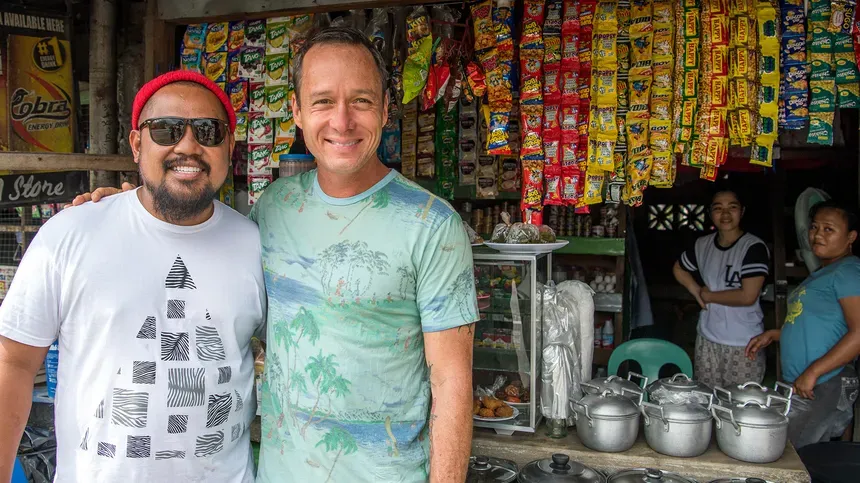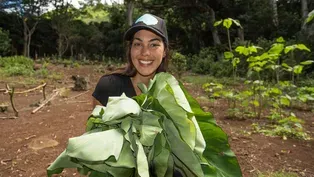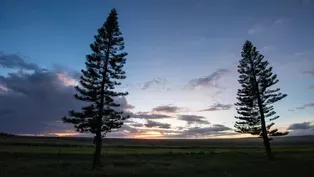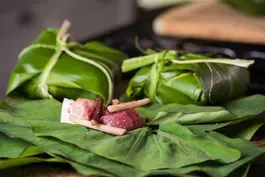
Lana’i Venison
Season 2 Episode 6 | 25m 31sVideo has Closed Captions
Anela Marie Kawehikulaonalani Evans shares the love and respect she has for her island.
Hawaiian hula dancer, cultural practitioner, and sustainable hunter Anela Marie Kawehikulaonalani Evans shares the love and respect she has for her island home. Join Family Ingredients as we follow Anela from the hunting grounds of Lana’i Island to the largest hula competition in the world, the Merrie Monarch Festival.
Problems with Closed Captions? Closed Captioning Feedback
Problems with Closed Captions? Closed Captioning Feedback

Lana’i Venison
Season 2 Episode 6 | 25m 31sVideo has Closed Captions
Hawaiian hula dancer, cultural practitioner, and sustainable hunter Anela Marie Kawehikulaonalani Evans shares the love and respect she has for her island home. Join Family Ingredients as we follow Anela from the hunting grounds of Lana’i Island to the largest hula competition in the world, the Merrie Monarch Festival.
Problems with Closed Captions? Closed Captioning Feedback
How to Watch Family Ingredients
Family Ingredients is available to stream on pbs.org and the free PBS App, available on iPhone, Apple TV, Android TV, Android smartphones, Amazon Fire TV, Amazon Fire Tablet, Roku, Samsung Smart TV, and Vizio.

Get Recipes and More
Learn about host and chef Ed Kenney, explore recipes from the show and more.Providing Support for PBS.org
Learn Moreabout PBS online sponsorshipThere's a newspaper article, and the last quote was, "On Lana'i, there's always a reason to smile."
Ed: Oh, how is that?
I would rock that.
Life on an island is all about balance, especially if you're a hula dancer and an avid hunter.
Every dish has a story.
Food brings people together and has the power to conjure up cherished memories.
Jack Johnson: ♪ Oh, you're such a pretty thing ♪ ♪ I'll take you and I'll make you all mine ♪ Ed: I was born and raised in the Hawaiian Islands, one of the most diverse communities in the world.
Johnson: ♪ We can watch it from the clouds ♪ ♪ We can't stop it anyhow, it's not ours ♪ Ed: In this show, we'll meet a guest from Hawai'i, learn about their favorite dish, trace it back to its origins, and have some fun along the way.
Johnson: ♪ Oh, you're such a pretty thing ♪ ♪ I'll take you and I'll make you all mine ♪ Ed: Imagine owning an entire island.
One rule--you won't be living there by yourself.
The island will have resources, livestock, and a small community, and maintaining them will be your responsibility.
The island of Lana'i, one of Hawaii's 7 major islands, has been privately owned for more than a century.
It is said that the island was originally inhabited by ghosts, who were then banished by a young Hawaiian warrior.
Lana'i then became known as the favorite fishing spot of Kamehameha the Great.
Then, in the 1870's, most of the island was purchased for commercial enterprise.
Lana'i has since passed through the hands of many different owners.
Today there is a resurgence of indigenous knowledge, and their relationship with the land has moved deeper than just commodity.
No better way to understand this than by visiting Lana'i.
But our journey starts here on O'ahu to meet our special guest.
Every chance I get to hang out with this movement of young Hawaiians that really take pride in who they are, where they came from, their cultural roots, I always jump at the opportunity.
I was really excited to meet Anela.
I look at her as a human study in contrast.
She's fluent in the Hawaiian language.
She dances hula for a halau that competes in the Merrie Monarch Festival, and on the other hand, she's an avid hunter, outdoorsperson.
Aloha.
Aloha.
So great to meet you finally.
Nice to meet you, too.
Right on.
So, this is your mom's house?
This is my mom's house.
It's not the house I grew up in.
So, um, hula... Did you start dancing hula young?
One of the earliest memories I have is my first ka pa hula, the first day I went to class.
I'm pretty sure I was around 4 years old.
It seems almost like a rite of passage when you grow up, hula lessons.
I remember my daughter would come home with, like, the uli'uli.
I had the opportunity to join the halau that I'm still in today.
I really found my place there.
[Woman speaking native language] Welcome to Kumu Maelia Halau.
What's up, cuz?
What's up?
Anela: You know, hula is life.
[Speaking native language] Anela: We don't just practice our culture and our traditions.
It's a lifestyle.
Ed: This halau has been going for a long time.
Anela: This is the halau's 25th anniversary this year.
This journey to Merrie Monarch is pretty special because we're celebrating 25 years of halau.
There's just something about when that song starts and we start dancing together, everything clicks.
Yeah, and there's something spiritual about it, it seems.
Yeah, and it's so special.
Ed: The Merrie Monarch Festival takes place annually in Hilo, Hawaii.
It honors King David Kalakaua, who is credited with restoring many Hawaiian traditions.
The highlight of the festival is a 3-day hula competition.
I love your story-- native Hawaiian girl, grew up in Lana'i, avid hula dancer, environmental activist, cultural practitioner, and at the same time, devoted hunter.
We always start out with asking the inevitable question-- do you have a favorite food memory growing up?
Most of my memories have to deal with, of course, Hawaiian food, yeah.
My favorite food memory is eating laulau.
and in particular, venison laulau.
I love the luau leaf.
That's my favorite part.
Yeah, seriously.
Oh, God.
I'm getting hungry.
Laulau is a staple in Hawaiian cuisine, and you'll be able to find this local dish at every Hawaiian party.
It is my comfort food.
Beef or pork is seasoned, and it is bundled up in taro leaves.
It is then wrapped in ti leaves to seal in the moisture while it steams in an imu, or underground oven, for 6 to 8 hours.
When done, the meat is rich and tender.
In Anela's version, she uses venison, wild deer that roam throughout Lana'i and Moloka'i.
In the 1800's, axis deer were brought into Hawai'i as a gift to Kamehameha the Fifth.
Without any natural predators, these deer grew rapidly and have now become a source of subsistence for the community.
There are more rules to owning your own island.
It will be remote.
To some people, this is their idea of heaven, but it also has its costs.
A barge brings supplies to the island once a week.
If it doesn't show, then hopefully you have rationed enough resources to get by.
This makes living on an island much more interesting.
First day on Lana'i, we started out at the Lana'i Heritage Center.
I cannot think of a better place to have started this journey.
Anela: So, this is a community nonprofit.
It was opened in 2008.
It's just pretty much to tell the history of Lana'i and its people.
There's such a rich heritage here.
Ed: Oh, how's that?
I would rock that.
Anela: From the 1920's until its closure in 1992, Lana'i was the premier location for pineapple growth in the world.
It was virtually the whole island, right?
Yeah.
You know, nowadays, the community reflects that pineapple culture as... You can see it reflected in the ethnicities that are represented here.
Ed: It was great to get my bearings, and whenever I come to a place, especially when you're just kind of shuffled from place to place, you really don't realize where you are.
So we got to take a look at the topographical maps.
A majority of the people on the island, residents, live here, but is there actually any people that live anywhere else on the island, homes?
Um, there are some luxury homes down by the resort.
But other than that, a majority of the population resides in this... That's pretty much it.
There's no home or anything?
Wow.
Yeah.
So, the majority of the population resides in this little mile-by-mile block, you know.
Ed: It's kind of a tradition when you come to a place, that you oftentimes want to meet the kupuna, or the elders of the area, and we are very fortunate to have Aunty Lai come down to the Heritage Center to greet us to the island.
For me, it was an incredible experience.
She's 101 years old.
[Speaking native language] So, you're trying to come up with a word for "chef."
Yeah.
No Hawaiian word for "chef."
Everybody cooked back in the day, right?
Ed: Then who is this?
Daniel Kaopuiki?
Oh, my parents.
Oh, this is your parents?
Yeah.
Ed: 1983.
How many siblings did you have?
[Speaking native language] Fourteen?
Ho!
[Speaking native language] Ed: Thank you so much for sharing.
The stories are beautiful.
Ed: I'm ready to dive in deeper and see more of this island and meet more of the people and eat more of the food.
Anela: We got to check out Chef Kemar, and he was kind enough to host us at his restaurant, One Forty, and let us taste his interpretation of a venison dish.
It was fancy schmancy, and it was delicious.
Hey, chef.
Hey.
Aloha, aloha.
Thank you.
This is unreal.
It's beautiful.
You're very welcome.
Ed: This big guy grew up in California, cooked in Honolulu at one of the top hotels there for two years before finally seizing the opportunity to move his whole family over here.
Venison is really an uncommon ingredient in Hawai'i.
It's not considered something that you see every day, even though it's so abundant on this island.
So it was great to be able to try the food cooked by someone that's very familiar with this ingredient.
I try not to mask as much of the flavor because, I mean, it's so clean, and we want to educate, because a lot of people feel that, you know, venison is something that is way out, only for the hunters or people that are used to growing up on those things.
It's comparable to fillet.
Ed: He did it really simply prepared, just seared it in a pan, butter-basted it, cooked it perfectly to a rare medium-rare, and then garnished it with some Mediterranean ingredients-- a little bit of polenta, a simple brown sauce made from a reduction of venison, some fresh arugula, tomatoes.
It looked fancy, but the flavors were so simple, and it really let the flavor of the venison shine.
With me being a chef and going through all the trials and tribulations that I did to get to this point, I was always taught to respect the food, respect the food, respect the food.
You know, what better way to respect it than to learn how it's grown, help cultivate it.
You know, now I've taken my hunting classes.
I know you're an avid hunter.
I want to harvest and go from the beginning to the end, and that's something that I'm also teaching my children, you know, is that a lot of people are getting away from Mother Earth, and this gave me an opportunity to still do and pursue my career but at the same time, get closer to Mother Earth, so-- Ed: But it's really refreshing to see people like Chef Kemar come in and respect this place and really try to integrate himself and his family.
You ever make laulau?
Laulau?
No, not yet.
That's what she is going to teach me.
What are you doing tomorrow?
I'm making laulau.
OK. Ha ha!
Ed: Lots of people that grew up in rural areas, we're finding them moved to the cities because of opportunity.
Even people that grew up in Hawai'i, plenty of them are moving to the mainland.
You're interesting, because you've actually chosen to move back to Lana'i.
Yeah.
After I graduated with my master's degree, I moved to Maui, and then, um, my dad passed away.
It was during that time that I kind of really reevaluated what I wanted in life.
I always knew that my ultimate goal was to move home to Lana'i.
You know, it's the place that my dad loved so much.
He loved the simplicity of it.
There's a newspaper article from 1986, I think, that was written about him, and the last quote was, "On Lana'i, there's always a reason to smile."
Anela: I wanted to do something fun and different that you wouldn't normally get to do on another island.
On Lana'i, we have miles and miles of dirt-road trails, a fun way to explore some of the island that's not always accessible.
So, this is the wahiva.
It's an ancient petroglyph field.
Ed: When you say "ancient," how ancient?
Pre-contact.
We're not sure.
Well, I'm not sure.
Hundreds of years, not thousands.
Hundreds of years, yeah.
Along these boulders, there's petroglyphs, and they depict of the ancient life in the area.
This is pretty amazing.
Just think how deep they were originally.
Yeah.
So, we're gonna go check out Hi'i, the agriculture heiau.
Ed: Heiau are really a spiritual place of worship.
Lots of times, people went there for refuge.
This one happened to be for agriculture, and you know how I feel about growing food.
[Singing in native language] Anela: So, these berries make this beautiful blue dye.
Ed: Oh, wow.
Look at that.
I know I've always thought there's no such thing as a blue food.
Anytime that you eat something that's blue, you know it's got an artificial color in it.
How do you know I can eat it?
Kind of tasted like a cactus plant or like a dragon fruit.
Not a whole lot of flavor.
Kind of that little gelatinous white on the inside.
But it was blue.
Wow.
Wauke wauke.
They mash them and boil it, and it makes a dye to dye kapa, yeah.
There's actually a blue food.
So, I can go anywhere?
Yeah.
Ed: The main reason we went there is because there's a little mala of kalo, a little garden of taro, and we went there to pick the leaves because we were going to make laulau with venison and the leaves from the taro plant.
Anela: You just have to cut the lau 6 to 8 inches down the stalk.
Ed: Do you put the stem inside the laulau?
Anela: Yeah.
You can clean them up.
It's the best part.
Yeah.
This is good, huh?
Yeah, that's good.
How many do you put in one laulau?
Mmm... about 5 or 6.
There you go.
Yeah.
Anela: Yeah, we're going to make some venison laulau today.
I'd love to learn the Lana'i style.
Got some la'i, ti leaves, some luau leaf that we gathered, got a venison backstrap, and then to add some of that good fat, we've got some... You've got to have this-- pork belly with the skin still on.
The first thing we have to do is cut up the backstrap.
So, did you harvest this?
I did.
I come from an old French background, so we always trim off all this silver skin.
Yes, exactly.
You do that over here, too?
Because this doesn't ever cook away, so it's like eating rubber band.
So, there's, like, 5 deer for every person on this island, right?
They're an invasive species, you know, and they've wreaked havoc on a lot of our native ecosystems and our watershed.
Usually laulau, we do, like, yeah, 1 1/2 to 2 inch cubes.
Oh, you go cubes.
You don't go big hunk like this.
Yeah, because then it's easier.
It breaks it down easier, yeah.
And they don't have to cook so long.
Yeah, exactly.
God, look at this meat.
So beautiful.
So, next we're gonna prepare our luau.
So, "lau" is just a generic term for leaf, and then "luau" is this.
This particular kalo leaf.
Go ahead and cut out the piko.
And this you put inside the laulau, too?
Yes.
And then usually I clean it and then section it off.
I love it.
Cooking off the thumb.
That's home style, mom style.
It's like, "I don't need a board."
Everything is off the thumb.
So, next we're going to debone the ti leaf, the la'i.
I'm going to bite right here, where the mid-rib gets a little thick... and then I'll just run my finger down to remove all of this to make the leaf more pliable.
So, this is similar to when you make skirts for hula, right?
Yeah, except I like my cut to be clean.
So I slice with a knife and then debone, yeah.
[Snap] I don't know how you did that.
Years of experience...
There you go.
Easy.
Practice.
I didn't go deep enough or something, because I... Oh, yeah.
That one is maybe young.
Yeah, it's the leaf's fault.
Usually I take one face down, get some lau-- larger ones are on the outside-- and just stack them.
Take a piece of venison, a piece of pork.
And then this is pa'akai, or Hawaiian sea salt, that was from this island?
Yeah.
So, this particular variety is alaea, or the red salt.
And that's just from the red volcanic soil?
Yeah.
Then we'll add in some of the ha.
Wrap it all up.
Place it on our ti leaf.
Make a bundle.
This is real kind of traditional, when you're making, like, 300 for a baby luau, lots of times we'd cheat and use tinfoil, right?
So, you can do that as well, yeah.
This is the hardest part right now, because whenever you make something with luau leaf, you've got to wait 3, 4 hours for it to cook so you don't get that itchy throat thing.
We're actually going to throw it in a pressure cooker.
And how long does that take?
Takes about an hour.
See?
I knew I'd learn something different.
Yeah.
So, you just put a little bit of water inside there.
Put a little bit of water, and then we have a steaming rack here.
And it really only takes one hour?
Yeah.
I love pressure cookers.
This was just great to know that you can, at home, make 4 or 5 laulau for your family, throw it in the pot, and one hour later, you'll be eating.
All right!
So juicy.
What are your thoughts, Ed?
This is comfort food to a "T," but it's comforting, but it's different, because I've never had it before, you know, with the venison.
Mm-hmm.
Mmm!
You would never know that it wasn't... Uh-uh.
God, it just... it just seems right, you know.
We harvested the luau.
You harvested the venison.
This is something that you've been doing forever.
This just hits you, like, right here, you know.
Yeah, it really is comfort food, you know.
This is the best thing I've eaten in two seasons.
Not.
I guarantee you.
Yeah.
Really?
That makes me happy.
Ha ha ha!
Mmm!
So good.
Ed: I was asked before this episode how I felt about hunting.
I told them, you know, I'd rather golf than go hunting, and I hate golf.
Ha ha ha.
Anela: This is my go-to hunting rifle.
This is a .308-caliber.
It's pretty much my old faithful.
Did it come like this, or did you have it painted?
No.
I had this custom-dipped.
This artist on Maui did it.
And this you use mostly for venison, mouflon.
Yeah.
So, I've shot everything from deer, mouflon, goat on Maui.
This is a 12-gauge semi-automatic shotgun.
We can hunt with shotgun here as well.
My newest acquisition, which is another custom manufactured rifle... Ho!
One of my friends, he's a local tattoo artist on Lana'i, He drew this out for me.
Can I feel it?
Yeah.
So, don't point it at me.
Sorry.
Sorry.
I'm not.
Ha ha!
One of my prized possessions is actually my dad's hunting rifle.
This is, uh... Wood.
Yeah, wood.
So, it's a .30-'06.
This is pretty much, like, the only rifle he's ever owned.
So, a lot of gun enthusiasts, you know, they like to collect rifles, but he had this one, and he always said, "You only need one," you know.
Yeah, it'll get the job done.
Yeah, so this was his old faithful.
Growing up here, you know, there's a very big hunting community.
We grew up with firearms in our houses, and we're taught how to shoot when we were young, and you know, we're always taught the basics of firearm safety, though.
[Wind blowing] Ed: I think it's a responsibility I have as a chef to understand the whole life cycle of what I put on the plate.
Anela: Usually when we hunt, in those early-morning hours, are when the animals are moving.
It's when you have the greatest chances of seeing them.
There's different strategies that we can do.
Can sit and wait for the animals to come to us, or we can walk and try to find them.
Today we wanted to walk.
You know, we wanted to cover as much terrain as possible.
Ed: So, what I was, I was just kind of tagging along.
I hung back probably 20 or 30 yards with a GoPro.
I got to actually try my hand at being a shooter for once.
It's under that kiawe in the shadow right there.
There's a big buck.
Do you see it?
Ed: Whoa.
Whoa.
Check this out.
Yeah.
Score.
Being in the restaurant business, We don't go to bed till 1:00 or 2:00 in the morning.
I can probably count the sunrises that I've seen as an adult on both hands.
It was one of the most beautiful mornings I have ever seen.
Anela: The reason why I wanted to hunt today-- and I had this hunt planned for a while-- is because it's two years since my dad's passing.
After he passed, I always felt closest to him when I was out on the land, you know.
He loved Lana'i so much.
Shh... [Gunshot] Ed: The Hawaiian word "i'a" means food.
The word "aina" means the land.
[Singing in native language] It's sometimes difficult to see how things are tied together, but that's the benefit of living on an island.
You have the ability to clearly see the world around you.
You learn to value everything-- the earth, the wind, the sea, and the sky.
This will even affect your relationships.
Everything is deeply connected, and all these connections bring balance.
You realize that everything has a role or place.
Once you understand that, you can move as one.
Video has Closed Captions
Anela Marie Kawehikulaonalani Evans shares the love and respect she has for her island. (30s)
Video has Closed Captions
We cherish our kupuna, our elders. They are the keepers of all the stories. (2m 15s)
Video has Closed Captions
Laulau, a traditional Hawaiian dish, is usually made with pork or chicken. (3m 22s)
Providing Support for PBS.org
Learn Moreabout PBS online sponsorship













